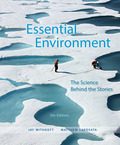
The four major types of health hazards that are examined by practitioners of environmental health.
Answer to Problem 1TYC
The four major types of health hazards are physical, chemical, biological, and cultural hazards that are examined by practitioner of environmental health.
Explanation of Solution
The environmental health hazards include chemical, biological, physical, and biochemical hazards that occurs in nature. It is caused by poor sanitation and shelter. It is also caused by using chemicals in agriculture and industries that contaminate air, land, food, and water.
There are four types of health hazards that are examined by practitioners which are as follows:
(a) Physical hazards: Physical hazards are caused by factors that are present in the environment and are harmful for life. Such factors cause serious health issues. These factors involve harmful ultraviolet radiation from sun whose long term exposure damages DNA and causes harmful diseases such as skin cancer, cataracts, and immune suppression.
(b) Chemical hazards: It includes several synthetic chemicals that are manufactured in industries such as pharmaceuticals, disinfectants, and pesticides. These chemicals may contaminate water, and food. It causes severe health problems. Some naturally occurring chemicals also accumulated into tissues of organisms and shows detrimental effects.
(c) Biological hazards: This type of health hazards occurs due to ecological interactions among organisms. There are several microorganisms such as virus,
(d) Cultural hazards: Cultural hazards are spread from one place to another due to personal habits, occupation, socioeconomic status, and lifestyle. For example, if someone is smoking and other person is just standing behind him, so both the persons are affected by smoking but one is an active smoker who smokes and other is a passive smoker who does not smoke but affected by smoke from cigarettes that spread in air and is inhaled by that person.
Want to see more full solutions like this?
- Discussion Question: Ecosystems Essentials A+ shof 1000 Exo-spil The Human Denominator Assignment As we learn about how the earth works, we learn to identify the different earth spheres and how they overlap and affect one another. An understanding of the Earth's systems and spheres takes practice. More importantly, we can see the "Domino Effect" of the spheres as they interact with one another. We have learned that while endogenic processes are separate from exogenic process, the lithosphere affects the atmosphere which affects the hydrosphere, and thearrow_forwardI need help with part c and darrow_forwardI need help with tracing over part A can someone help me outarrow_forward
- I need help with question 3 can someone help me.arrow_forwardI need help with tracing part A could I get some helparrow_forwardActivity 12.3: Wave Refraction Pgs 202-203Figure 12.2 is a map view of a headland along a coastline. The water depths are shown by blue contour lines. As you complete the following questions, assume that waves with a wavelength of 60 feet are approaching the shoreline from the bottom left of the figure. 1. At approximately what water depth-10, 20, 30, or 40 feet-will the approaching waves begin to touch bottom and slow down? (Hint: Recall that this occurs when the water depth is one-half the wavelength.) Approximately the 30-foot depth line. 2. Using the wave shown in Figure 12.2 as a starting point, sketch a series of lines to illustrate the wave refraction that will occur as the wave approaches the shore by following these steps:Step 1: Mark the position on the 30-foot contour line where the wave front will first touch bottom.Step 2: Knowing that the section of the wave that touches bottom will slow down first, sketch the shape of the wave front when it reaches the 20-foot contour…arrow_forward
- N Depth of water contour Advancing wave crest Beach HEADLAND -10'- 20'- -30- Land -40- -50'- 0 Beach Scale 200 feetarrow_forwardI need help on Part C question 2arrow_forwardcan you please show me the drawings for each of these i want to make sure I have them right, as well as explaing the answers, thank youarrow_forward
- I need help on Part Carrow_forwardI need help with part a and barrow_forwardIn fig A13.2.3, what are the gradient and sinuosity of Passage Creek from G and G? Refer to figs. 12.3 and 12.4 for help measuring gradient and sinuosity. Show your calculations. You will graph it later in the activity. Gradient: ______ ft/mi Sinuosity:arrow_forward
 Applications and Investigations in Earth Science ...Earth ScienceISBN:9780134746241Author:Edward J. Tarbuck, Frederick K. Lutgens, Dennis G. TasaPublisher:PEARSON
Applications and Investigations in Earth Science ...Earth ScienceISBN:9780134746241Author:Edward J. Tarbuck, Frederick K. Lutgens, Dennis G. TasaPublisher:PEARSON Exercises for Weather & Climate (9th Edition)Earth ScienceISBN:9780134041360Author:Greg CarbonePublisher:PEARSON
Exercises for Weather & Climate (9th Edition)Earth ScienceISBN:9780134041360Author:Greg CarbonePublisher:PEARSON Environmental ScienceEarth ScienceISBN:9781260153125Author:William P Cunningham Prof., Mary Ann Cunningham ProfessorPublisher:McGraw-Hill Education
Environmental ScienceEarth ScienceISBN:9781260153125Author:William P Cunningham Prof., Mary Ann Cunningham ProfessorPublisher:McGraw-Hill Education Earth Science (15th Edition)Earth ScienceISBN:9780134543536Author:Edward J. Tarbuck, Frederick K. Lutgens, Dennis G. TasaPublisher:PEARSON
Earth Science (15th Edition)Earth ScienceISBN:9780134543536Author:Edward J. Tarbuck, Frederick K. Lutgens, Dennis G. TasaPublisher:PEARSON Environmental Science (MindTap Course List)Earth ScienceISBN:9781337569613Author:G. Tyler Miller, Scott SpoolmanPublisher:Cengage Learning
Environmental Science (MindTap Course List)Earth ScienceISBN:9781337569613Author:G. Tyler Miller, Scott SpoolmanPublisher:Cengage Learning Physical GeologyEarth ScienceISBN:9781259916823Author:Plummer, Charles C., CARLSON, Diane H., Hammersley, LisaPublisher:Mcgraw-hill Education,
Physical GeologyEarth ScienceISBN:9781259916823Author:Plummer, Charles C., CARLSON, Diane H., Hammersley, LisaPublisher:Mcgraw-hill Education,





